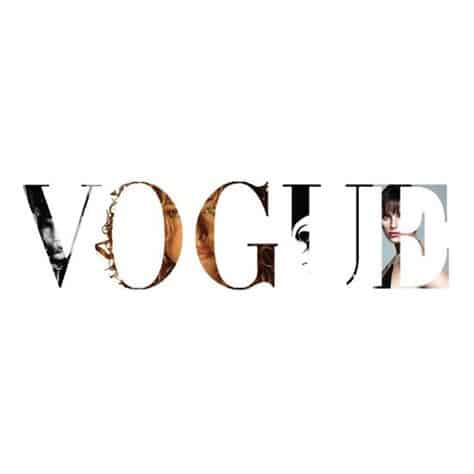Vogue is the world’s largest and most famous fashion magazine, and it has evolved with the times. The Vogue logo is truly legendary, allowing the font to speak for itself while remaining distinctive. Since its inception in 1892, the magazine has expanded to be distributed in 23 countries and has approximately 11 million subscribers. Although both the magazine and the logo have evolved, some iconic elements have remained.
The familiar and iconic font that is at the heart of the logo has been retained. The magazine has retained elements that make it memorable and familiar as well. Let’s take a look at what’s at the heart of the logo and magazine that hasn’t changed over time.
History of the Vogue Logo
The iconic Vogue logo, which includes the magazine’s black name, has evolved over time. First, the cover lettering was created by hand. The designer created a new version for each new issue to correspond with the thematic content of the articles. The weekly’s target audience shifted in 1909. He decided to take his business to the next level, so he hired professional artists to portray his name in the style of the jazz era or in the art deco direction.
The first issue of Vogue, published in 1932, featured a logo in delicate white letters. Designers could still experiment with different fonts, ranging from sans serifs to serifs. In 1955, the publication began to use a Didot family typeface on a permanent basis.
Given that the magazine was founded in 1892, the modern version of the word mark existed not long ago. It was inspired by the mid-1950s inscription on the cover. The designers have tweaked the design over time to keep up with fashion trends.
Capital letters, long serifs, and a strong contrast between thin and thick lines distinguish the Vogue logo. All of this makes it stand out against any background, regardless of what photo designers use for decoration.
The Vogue brand name is made up entirely of lettering. It demonstrates impeccable taste and complements any background, particularly with images from the world of haute couture. The previous logos were inconsistent: the weekly experimented with shapes and styles, allowing for drawn elements. Everything changed in 1955, when the magazine’s editor-in-chief decided to make the design more utilitarian and consistent. The new word symbol emphasized Vogue’s high status as a global fashion guide.
The Vogue Logo: Evolution
1892 – 1907
A curved inscription with its name adorns the cover of the fashion edition. The letters are thin and graceful, similar to the background on which they are set. This is a curly, wide ribbon with twisted ends. Elegant ladies in chic outfits sit to her right and left. One looks in the mirror, while the other flips through a magazine. These characters play a critical marketing role. They emphasize the target audience for the print edition, report on its subject (beauty and everything related to it), and emphasize the magazine’s accessibility to everyone. Columns in the style of ancient Greece and flowering tree branches are depicted in the background.
1907 – 1908
Following the multi-structured image, the magazine received a minimalistic version of the logo. She moved from one room to the next, remaining constant. This was the initial title. Sharp serifs and long curls with a dot at the end balance out the ornate letters. The letters “O” and “G” are connected like rings, creating the appearance of a monogram right in the word “Vogue.”
1908 – 1910s
The designers made the letters bolder, which gave the logo a business-like, significant, and large appearance. The upper corner of the “G” has grown long and pointed.
1910s – 1940s
The inscription lost its decorative elements and became lighter in weight. To accomplish this, the designers eliminated dots and long serifs and made the letters wider than before. As a result, there is more inter-character space.
1940s – Present
This popular style of cover lettering has become legendary. The classic font is refined and professional, thanks to the harmonious combination of narrow and wide stripes in each letter. This combination, on the one hand, makes the emblem both catchy and sophisticated. The glyphs are so close together that the serifs “U” and “E” appear to be one element.
Vogue Logo: Colors and Font
The typography hasn’t changed much since the logo’s unified design. This was unnecessary because the Didot typeface was suitable for any cover, regardless of its subject matter. It alternated with the Bodoni family of typefaces designed by Giambattista Bodoni, an Italian designer. Both types of fonts share a high contrast between strokes of varying thicknesses. Vogue designers, of course, have changed some of the nuances over time. They updated the Didot while retaining its classic elegance. In addition, the name of the magazine can be written in the signature Vogue AG grotesque, which was inspired by Avant Garde Gothic and Futura. Terminal Design Studio created it.
The main color of the logo is black because it is a timeless classic. The fashion edition, however, is not limited to the traditional color palette. Color schemes are boldly experimented with by editors so that the lettering blends harmoniously with other cover elements, most notably the background photo.
Vogue Magazine’s History
Vogue magazine is the most influential and recognizable fashion publication. But did you know when the magazine was first published and how the various publications have evolved over time? Continue reading to find out more.
Early Years: 1892–1905
Vogue was founded in New York as a weekly paper by an American businessman named Arthur Baldwin Turnure and was funded by Kristoffer Wright. The first issue was published in December 1892, with a cover price of ten cents (equivalent to $2.88 in 2020).
Since its inception, Vogue has catered to New York’s upper class, chronicling their habits, leisure activities, hangout spots, social gatherings, and clothing, as well as anyone who wished to emulate them and join their exclusive circle. Vogue was primarily concerned with fashion, social issues, and sports coverage at the time. Growth was understandably slow in the early stages.
Ownership of Condé Nast: 1905—1920
Condé Montrose Nast purchased Vogue a year before the death of founder Baldwin Turnure in 1909. In the 1910s, Condé Montrose Nast renamed Vogue a ladies’ magazine and began publishing it in other countries. He also raised the price.
The magazine’s publications and profits increased dramatically under Nast’s leadership. It continued to target an affluent audience and expanded into wedding coverage. When Vogue deliveries became impossible in Europe, Asia, and Africa due to World War I, printing began in England, according to Nast. This decision proved successful, prompting Nast to publish the first issue of Vogue in French in 1920.
Expansion Period: 1920–1970
During the Great Depression and World War II, the number of Vogue subscriptions skyrocketed. During this time, Condé Nast hired Frank Crowninshield, a renowned critic and ex-Vanity Fair editor, to be Vogue’s editor.
In July 1932, American Vogue published its first color photograph on its cover. Edward Jean Steichen captured the image of a female swimmer in the air clutching a beach ball.
According to Laird Borrelli, Vogue oversaw the decline of fashion illustration in the late 1930s when it began to replace illustrated covers with photographic images.
Nast pioneered the “two-page spread” as well as color printing. He is rightfully credited with turning Vogue into the highly successful women’s magazine we know today, significantly increasing its sales volumes until his death in 1942.
The 1950s were Vogue’s most influential years, when Jessica Daves was hired as editor-in-chief. Daves successfully guided Vogue through one of its most difficult, transformative, and prosperous periods in history. While fashion coverage remained the top priority, Daves expanded American Vogue’s written content, emphasizing stronger literary features and arts coverage.
Read Also: St. Louis Cardinals Logo: History, Meaning, EvolutionRead Also:
Daves’ tenure at Vogue ended in 1962, when Diana Vreeland was hired (at first as an associate editor before taking over as editor-in-chief in December 1962). The two editors used diametrically opposed methods to edit Vogue. While Daves thought fashion was a serious business, Vreeland thought it was purely for entertainment. Vreeland later led Vogue into a period of vitality and youth, as well as “extravagance, excess, and luxury.”
Vogue began to attract the youth during the sexual revolution era in the 1960s, led by Editor-in-Chief Diana Vreeland, by focusing a lot more on editorial features and contemporary fashion that openly discussed sexuality.
To achieve this goal, Vogue expanded its coverage to include East Village boutiques such as Limbo at St. Marks Place, as well as features of “downtown” personalities such as Jane Holzer’s favorite joints and Andy Warhol’s “Superstar.” Vogue also continued to turn models into household names, including Suzy Parker, Twiggy, Lauren Hutton, Jean Shrimpton, Penelope Tree, Marisa Berenson, Veruschka, and many others.
Read Also: Fidelity Logo: Evolution, Meaning & History (Updated)
In 1973, Vogue was transformed into a monthly publication. Under the new editor-in-chief, Grace Mirabella, the magazine underwent extensive stylistic and editorial changes to keep up with its audience’s changing lifestyles. Mirabella claims she was chosen to change the magazine because women were tired of buying or reading about clothes because it didn’t make a difference in their changing lifestyles.
Mirabella was brought in to make Vogue more appealing to “the free, “liberated” working woman of the 1970s. She transformed Vogue by including text in interviews, serious health articles, and arts coverage. Mirabella was eventually fired when that kind of stylistic change fell out of favor in the 1980s.
Stewardship of Anna Wintour: 1988–Present
After Vogue began to lose ground to the 3-year-old startup Elle, Anna Wintour was named the new editor-in-chief. Wintour, known for her signature sunglasses and bob cut, sought to revitalize the magazine by making it more approachable and youthful. She shifted her focus to new and approachable fashion concepts for a broader audience.
Vogue was able to maintain its high circulation under Wintour’s leadership, and its staff discovered fresh new trends that its larger audience could afford. For example, the first cover of Vogue under Wintour’s direction featured a 34-length photo of Israeli model Michaela Bercu wearing jeans and an embellished Christian Lacroix jacket.
This was in stark contrast to her predecessor’s preference for only depicting the face of a woman. The New York Times reported at the time that this move prioritized not only women’s clothing but also their bodies.
Read Also: Tory Burch Logo: The Full Story Behind Tory’s Success
During her time at Vogue, Wintour accomplished her goal of revitalizing the publication and oversaw the publication of some of the magazine’s most important issues. With 832 pages, the September 2004 issue of the magazine was the largest ever monthly publication. Wintour is still the editor-in-chief of American Vogue today.
Condé Nast executives were concerned that the mother of fashion magazines, Vogue, was losing ground to Elle, a 3-year-old publication that had circulated 851,000 copies compared to 1.2 million copies of Vogue. As a result, Condé Nast hired Anna Wintour, 38, who rose to prominence as editor-in-chief of House & Garden and British Vogue, and was known for her forward-thinking visual sense as well as her ability to completely revitalize a magazine.
Influence and Style
Vogue means “style” in French. According to book critic Caroline Weber, Vogue is “the most influential fashion publication in the world,” with 11 million US readers and 12.5 million international readers. Furthermore, Anna Wintour has been named one of fashion’s most powerful figures.
Social
Every year, Vogue hosts the Met Gala to celebrate the opening of the Metropolitan Museum’s fashion exhibition. It is the most coveted annual fashion event, attended by politicians, A-list celebrities, fashion editors, and designers. The themed fashion event has been held by Vogue since 1971 when Diana Vreeland was editor-in-chief.
Music
American Vogue named the “15 roots reggae tunes you need to know” in 2015. During an interview at VP Records, the magazine drew viewers’ attention to an edited list of legendary reggae artists who recorded in Kingston, Jamaica, including Bob Marley, Gregory Isaacs, Peter Tosh, Burning Spear, Dennis Brown, The Heptones, Bunny Wailer, and Toots & the Maytals.
Aside from covering legendary artists, Vogue provides the most recent music news on artists such as Taylor Swift, Eminem, Jay-Z, and Tom Petty, as well as acting as an influencer. For example, in 2017, Vogue was responsible for popularizing American musician Suzi Analogue.
Technological
In the September 2003 issue of Vogue, the magazine collaborated with Google to market Google Glass in a 12-page spread.
Within the 832 pages of the September 2015 issue of Vogue, technology such as Amazon Fashion, Apple Watch, and Apple Music were all represented.
Economic
Anna Wintour launched the “Fashion Night” initiative in 2009 with the goal of revitalizing the economy following the 2007-2008 financial crisis by attracting customers back to retail stores and donating the proceeds to a variety of charitable causes.
Vogue co-hosted the event in 27 cities across the United States and 15 countries around the world at the start of 2011, and it included online stores. There was some debate about whether the event was profitable in the United States, which led to a possible permanent break in 2013. However, the event is still held in 19 other locations around the world.
Political
By recognizing the burga and featuring several articles about renowned Muslim women, their attitude toward fashion, and the impact of various cultures on women’s lives and fashion in 2006, Vogue drew attention to salient cultural and political issues.
Vogue also contributed $25,000 to the “Beauty Without Borders” initiative, which launched a cosmetology college for Afghan women. A Liz Mermin documentary on the rise of Western beauty standards criticized the beauty school, claiming that it couldn’t be considered successful unless it created demand for American cosmetics.
During the 2012 United States Presidential Election, Wintour used her industry connections to host a number of large fundraisers in support of Barack Obama. The first fundraiser, held in 2010, was a $30,000 dinner for each attendee. The “Runway to Win” campaign hired prominent designers to create outfits to support the Obama campaign.
Vogue declared its support for Hillary Clinton’s presidential campaign in October 2016. It was the first time in Vogue’s 120-year history that the brand spoke out in support of a presidential candidate.
Conclusion
Vogue, founded in 1892, is arguably the world’s most influential and well-known fashion and society publication. Throughout its history, the fashion magazine has published over 400,000 article pages to a global audience, claiming 11 million readers in the United States and 12.5 million readers worldwide. It’s difficult to ignore the magazine’s dominance with such a track record.
Although Vogue is now published monthly, it began as a weekly newspaper for high society in America. It primarily covered upper-class social news, book and concert reviews, and social etiquette.
As evidenced by its covers, Vogue has progressed significantly from its initial emphasis on elitism and etiquette. With a focus on “healthy body, sexual equality, and freedom,” the magazine plays an important role in the world of fashion.
The British Vogue, founded in 1916, was the magazine’s first international edition. Vogue Italia, the Italian version, is one of the world’s most popular fashion magazines. Vogue currently has at least 26 international editions. Despite its simplicity, the Vogue logo is recognized by millions of people worldwide.
Vogue Logo: Related Articles
- COLLEGE GRANTS: Best Available Options for Women & any Student
- IASB (International Accounting Standards Board) Roles, Framework & Benefits
- 2023 Fortune 100 List of Companies Updated!!!
- Content Marketing: Best Easy Guide (+Free Course)
- 2023 Fortune 500 Company List Compilations & Insights (Updated)






